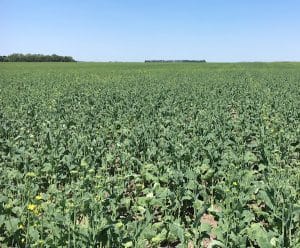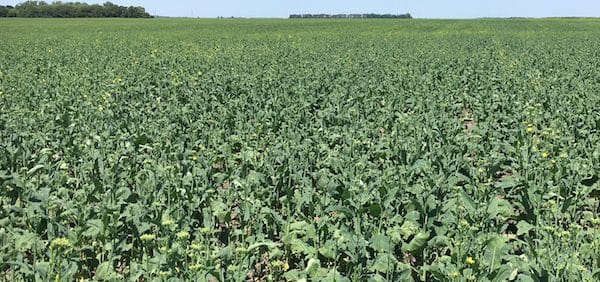As earliest canola crops start to flower, the annual sclerotinia stem rot management conversations begin. With good yield potential and moisture before, during and after flowering, a fungicide application will often provide a return on investment for canola growers. Dry conditions and lower yield potential can reduce the return on investment for fungicide.

Moisture before flowering will result in the emergence of spore-producing apothecia. Moisture during flowering will enable spores to infect canola petals and grow into leaf and stem tissues when the infected petals fall into the crop canopy. Moisture after flowering will promote infection that can lead to an economic loss of yield. After flowering is too late to spray, so the decision has to be based on the situation during the spray window — which is 20-50% flower — and your own forecast of weather to come.
In a paper called “Managing sclerotinia in oilseed and pulse crops” printed in Soils and Crops Journal in 2011, the authors describe factors that will increase and decrease the risk of sclerotinia stem rot in canola.
Overall, risk of economic levels of sclerotinia stem rot INCREASES when these occur:
—History of significant levels of sclerotinia in the specific field or in adjacent fields
—Adequate June rain and moderate temperatures favour germination of sclerotia once crop canopies start to cover the soil surface
—The soil surface underneath the canola canopy remains wet for most or all of the day
—Apothecia are easily found in the specific field or adjacent fields
—Unsettled conditions in late June and throughout July with frequent showers interspersed with windy days without rain
—Increased yield potential (>30 bu./ac.) as a result of a combination of variety, high fertility levels, and good agronomic practices
—Moderate average temperatures of 15-25°C and moderate rainfall that favour host infection while extending the bloom period and reducing sloughing off of leaves, thus maintaining potential infection sites
—A crop canopy that remains wet throughout the day or at least until late in the afternoon, with droplets of moisture readily found in leaf axils and bases even in the late afternoon
—Extensive sticking/clumping of petals in the crop canopy especially in the leaf axils and bases.
In contrast, risk of sclerotinia stem rot is LIMITED when the factors above do not occur, and these do:
—Continuous rain events that may lead to washing off of petals from plants and remove spores from the air, while trapping spores in water droplets that form on the tops of the apothecia (note these conditions will not completely eliminate the risk of stem rot, but may lead to a lower level of disease than expected)
—Well below- or above-average temperatures (<10°C or >25-30°C) and limited rainfall will reduce the risk of stem rot even if there is a history of disease in the field or region
—A large rainfall event over 1-2 days that is followed by several days or 1-2 weeks of dry, warm conditions that typically do not favour apothecia production and host infection and thus the risk of stem rot
—High temperatures (daily maximums of >30°C) and sunny dry conditions that significantly limit the risk of infection as well as greatly shorten the flowering period, while promoting rapid leaf senescence and sloughing off of leaves, and thus removal of potential infection sites.
—A poor canola canopy. Crops with yield potential of less than 30bu./ac. may have thin canopies that are not conducive to disease development.
Conditions where a grower may want to spray more than once:
—Variable crop staging that extends the flowering period, but assess the yield potential before investing more in the crop.
—Thin stands with late branches that extend the flowering period, but assess the yield potential before investing more in the crop.
—Regrowth after a hail, but assess the yield potential before investing more in the crop.
Further reading:

